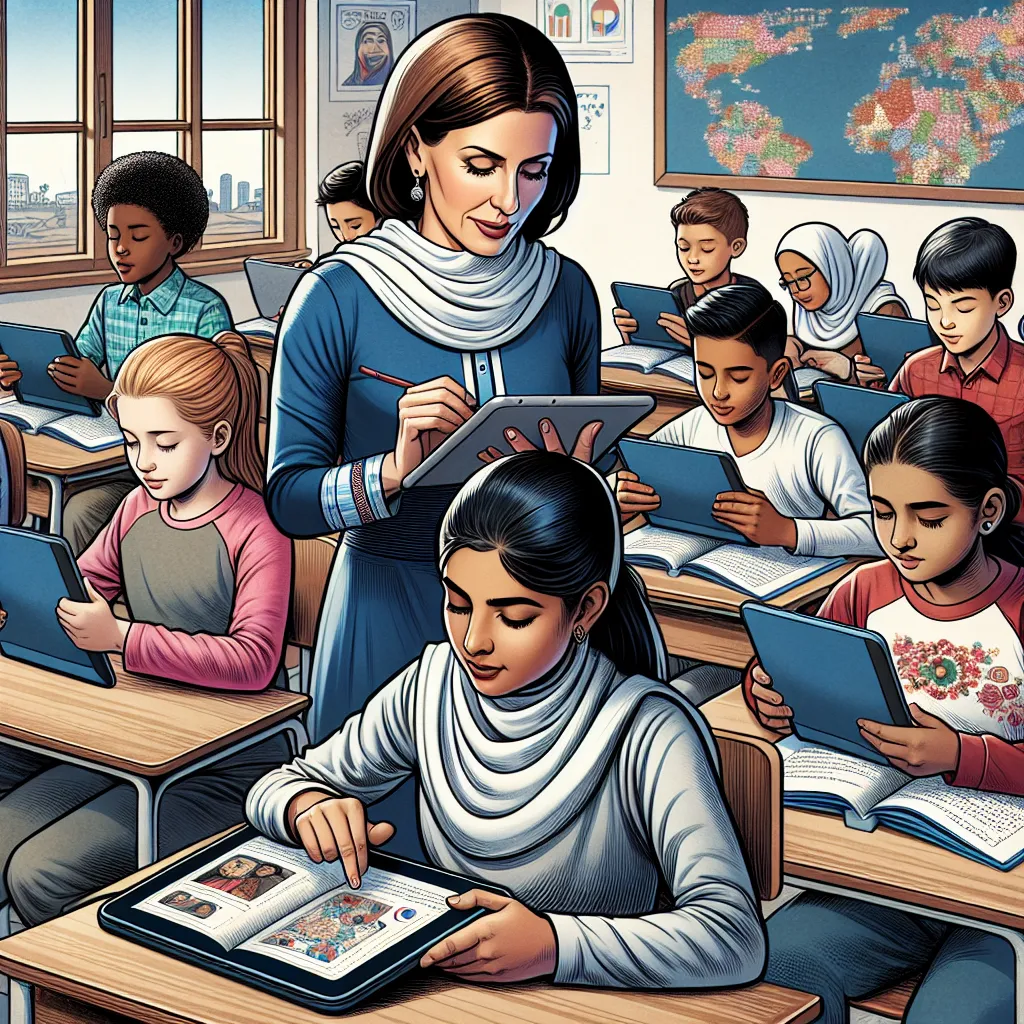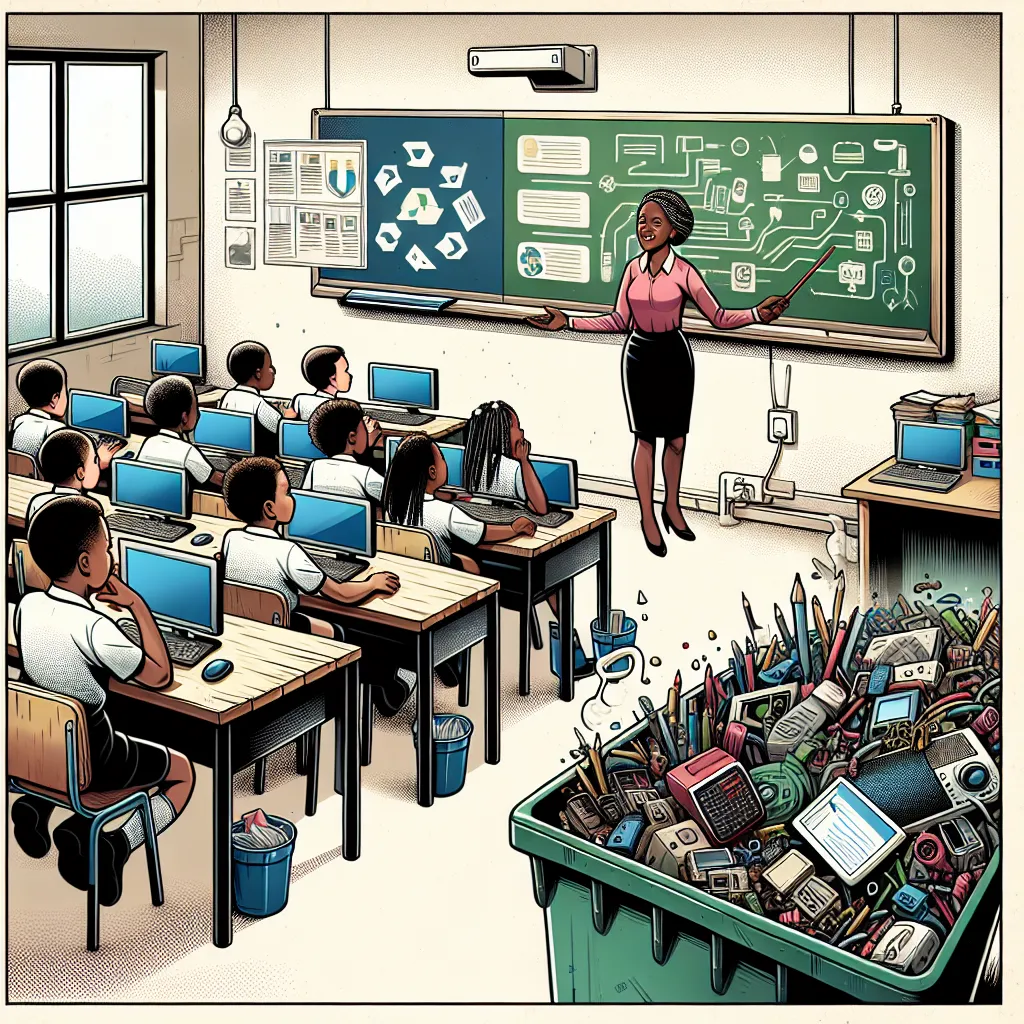Ask AI on The Internet
Question: Part 1: Understanding ICT Integration in South African Schools (40 marks) 1. Define ICT (Information and Communication Technologies) and explain why its integration is crucial in the context of South African education. [10] 2. Identify and elaborate on three significant challenges faced by South African schools when integrating ICTs into their educational framework. Provide specific examples if available. [15] 3. Discuss the digital divide issue in South African schools. How does it impact students' access to ICT resources and their learning experiences? Propose possible solutions to bridge this divide. [15] Part 2: Strategies to Support ICT Integration in Classroom Activities (40 marks) 4. Describe the SAMR (Substitution, Augmentation, Modification, Redefinition) model for technology integration. How can South African educators apply this model to enhance classroom activities with ICTs? [10] 5. Explain three innovative ways in which teachers can effectively use ICTs to engage students and facilitate active learning in the classroom. Provide examples for each. [10] 6. Discuss the importance of continuous professional development for educators concerning ICT integration. Outline specific training and support mechanisms that can empower teachers to use ICTs effectively. [10] 7. Explore the role of partnerships with local businesses or organizations in aiding South African schools with ICT resources and support. Provide examples of successful collaborations. [10] Part 3: Reflection and Future Action (20 marks) 8. On your personal experiences or observations regarding ICT integration in education. Share one specific example of successful ICT use in a classroom or educational setting and analyze why it was successful. [10] 9. As a prospective educator or concerned individual, propose three actionable steps that you can take to contribute to the integration of ICTs in South African schools. Explain how these actions could positively impact the educational landscape. [10] Marking Guidelines: • Each question is assigned a specific mark value (as indicated
**Part 1: Understanding ICT Integration in South African Schools (40 marks)** 1. **Define ICT (Information and Communication Technologies) and explain why its integration is crucial in the context of South African education. [10]** **Definition of ICT:** Information and Communication Technologies (ICT) refer to the tools and resources used to communicate, create, disseminate, store, and manage information. This includes computers, the internet, broadcasting technologies (radio and television), and telephony. **Importance of ICT Integration:** - **Enhanced Learning Opportunities:** ICT allows access to vast educational resources, opening up a world of knowledge beyond traditional textbooks. - **Equity and Inclusion:** Provides an opportunity to bridge the educational gap for students in remote or under-resourced areas through online learning materials and platforms. - **21st Century Skills:** Prepares students for the modern workforce by teaching essential skills such as digital literacy, communication, and problem-solving. - **Improved Engagement:** Interactive and multimedia tools can make learning more engaging and effective. - **Efficiency and Management:** Simplifies administrative tasks, record keeping, and can facilitate teacher-student communication. 2. **Identify and elaborate on three significant challenges faced by South African schools when integrating ICTs into their educational framework. Provide specific examples if available. [15]** **Challenges:** - **Infrastructure and Resources:** Many schools lack the necessary infrastructure, such as reliable electricity, internet access, and modern equipment. For instance, rural schools often struggle with connectivity, hindering consistent ICT use. - **Teacher Training and Competency:** Educators may lack the necessary training or confidence to effectively integrate ICT into their teaching practices. Continuous professional development is needed to bridge this gap. - **Financial Constraints:** Budget limitations can restrict the acquisition of ICT hardware and software, maintenance, and ongoing training programs. For example, underfunded schools might prioritize basic needs over technological advancements. 3. **Discuss the digital divide issue in South African schools. How does it impact students' access to ICT resources and their learning experiences? Propose possible solutions to bridge this divide. [15]** **Digital Divide:** - **Impact on Access and Learning:** The digital divide refers to the gap between those who have easy access to ICT resources and those who do not. This divide can result in disparities in the quality of education, with students in under-resourced schools unable to access the same educational materials and opportunities as those in well-equipped schools. - **Learning Inequities:** Students without access may miss out on developing critical digital skills, further perpetuating socio-economic inequalities and limiting their future prospects. **Proposed Solutions:** - **Government and NGO Initiatives:** Policies and programs focused on providing equitable access to internet and devices for all schools. - **Community-Based Solutions:** Local communities can establish shared ICT centers where students can access digital resources outside of school hours. - **Public-Private Partnerships:** Collaborations with tech companies to provide affordable or donated equipment and ongoing support. **Part 2: Strategies to Support ICT Integration in Classroom Activities (40 marks)** 4. **Describe the SAMR (Substitution, Augmentation, Modification, Redefinition) model for technology integration. How can South African educators apply this model to enhance classroom activities with ICTs? [10]** The SAMR model outlines four levels of technology integration: - **Substitution:** Technology acts as a direct substitute for traditional methods with no functional change. Example: Replacing printed handouts with digital documents. - **Augmentation:** Technology is a substitute but with functional improvements. Example: Using digital quizzes with immediate feedback. - **Modification:** Technology allows for significant task redesign. Example: Students collaborate on a shared digital document to write and edit a report in real-time. - **Redefinition:** Technology enables the creation of new, previously inconceivable tasks. Example: Students produce a documentary using multimedia tools and share it globally via a blog or social media. **Application in South African Classrooms:** - **Substitution:** Use e-books instead of physical textbooks. - **Augmentation:** Incorporate multimedia presentations to enhance lessons. - **Modification:** Enable real-time collaboration on projects using cloud-based apps like Google Classroom. - **Redefinition:** Create global learning projects connecting students with peers around the world through platforms like Skype or Zoom. 5. **Explain three innovative ways in which teachers can effectively use ICTs to engage students and facilitate active learning in the classroom. Provide examples for each. [10]** - **Flipped Classroom:** Teachers provide instructional content, often in video format, for students to study at home which frees up class time for interactive activities and personalized learning. Example: Using YouTube videos or Khan Academy materials. - **Gamification:** Incorporate game elements into learning activities to motivate students and make learning fun. Example: Using educational games like Kahoot! or Minecraft: Education Edition. - **Project-Based Learning:** Students use ICT to research, design, and present projects, fostering collaboration and critical thinking. Example: Students might use Google Earth for a geography project or create a blog to document their science experiments. 6. **Discuss the importance of continuous professional development for educators concerning ICT integration. Outline specific training and support mechanisms that can empower teachers to use ICTs effectively. [10]** **Importance:** - Keeps teachers updated on the latest educational technologies and methodologies. - Builds confidence and competence in using ICT tools. - Encourages innovative teaching practices. - Ensures effective implementation and utilization of ICT resources. **Training and Support Mechanisms:** - **Workshops and Seminars:** Conduct regular training sessions focused on specific ICT tools and pedagogical strategies. - **Online Courses and Webinars:** Provide accessible, self-paced learning opportunities. - **Peer Mentorship Programs:** Foster a community of practice where experienced teachers support their colleagues. - **Technical Support:** Ensure ongoing technical assistance to troubleshoot and resolve issues promptly. 7. **Explore the role of partnerships with local businesses or organizations in aiding South African schools with ICT resources and support. Provide examples of successful collaborations. [10]** **Role of Partnerships:** - **Resource Donation:** Businesses can provide ICT hardware like computers, tablets, and software licenses. - **Technical Support and Training:** Organizations can offer technical expertise and training programs for teachers. - **Sponsorship of Programs:** Companies can fund specific ICT projects or initiatives in schools. **Examples of Successful Collaborations:** - **Vodacom e-School:** Vodacom provides free access to online educational content for South African students. - **Khanya Project:** Supported by various partners, this initiative aimed to integrate ICT in Western Cape schools through the provision of infrastructure and training. **Part 3: Reflection and Future Action (20 marks)** 8. **Reflect on your personal experiences or observations regarding ICT integration in education. Share one specific example of successful ICT use in a classroom or educational setting and analyze why it was successful. [10]** **Example:** An observed practice at a secondary school where students used tablets for a history project to create interactive timelines using an app. The use of the app allowed students to integrate text, images, and videos, making the timelines engaging and informative. **Analysis of Success:** - **Engagement:** Students were more engaged as they could interact with the content in a dynamic way. - **Collaboration:** Encouraged teamwork as students worked in groups to complete the project. - **Creativity:** The app enabled students to express their creativity and present information in unique ways. - **Immediate Feedback:** Teachers could provide instant feedback on the digital timelines. 9. **As a prospective educator or concerned individual, propose three actionable steps that you can take to contribute to the integration of ICTs in South African schools. Explain how these actions could positively impact the educational landscape. [10]** **Actionable Steps:** - **Promote ICT Literacy:** - **Initiative:** Organize workshops for teachers and students to enhance digital literacy and confidence in using new technologies. - **Impact:** Empowers educators and learners, making them more adept at utilizing available ICT resources effectively. - **Support Funding Initiatives:** - **Initiative:** Advocate for and assist in fundraising efforts to acquire ICT equipment and infrastructure for under-resourced schools. - **Impact:** Bridges the resource gap, ensuring more equitable access to technology. - **Create and Share Digital Educational Content:** - **Initiative:** Develop and disseminate open educational resources (OER) tailored to the national curriculum to supplement teaching materials. - **Impact:** Provides teachers with valuable tools to enhance lessons and provides students with additional learning materials. **Marking Guidelines:** - Each question is assigned a specific mark value (as indicated). - Marks should be awarded based on the comprehensiveness, relevance, and depth of the response. - Quality of examples and practical applications should be considered in evaluating each answer.
Think your answer is better than the AI's? Post it below.
Other Most Relevant Posts:
 1. **ICT in South African Education**
2. **Challenges to ICT Integration**
3. **Digital Divide in Schools**
4. **SAMR Model for Educators**
5. **Innovative ICT in Classrooms**
6. **Professional D
1. **ICT in South African Education**
2. **Challenges to ICT Integration**
3. **Digital Divide in Schools**
4. **SAMR Model for Educators**
5. **Innovative ICT in Classrooms**
6. **Professional D
Question Tags
If you want your question answered by an AI, click here.






Post your own comment: